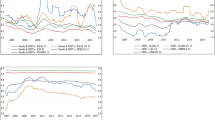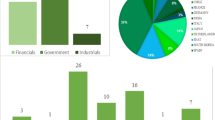Abstract
In this paper, we explore the features of a structural credit risk model wherein the firm value is driven by normal tempered stable (NTS) process belonging to the larger class of Lévy processes. For the purpose of comparability, the calibration to the term structure of a corporate bond credit spread is conducted under both NTS structural model and Merton structural model. We find that NTS structural model provides better fit for all credit ratings than Merton structural model. However, it is noticed that probabilities of default derived from the calibration of the term structure of a bond credit spread might be overestimated since the bond credit spread could contain non-default components such as illiquidity risk or asymmetric tax treatment. Hence, considering CDS spread as a reflection of the pure credit risk for the reference entity, we calibrate it in order to obtain more reasonable probability of default and obtain valid results in calibration of the market CDS spread with NTS structural model.




Similar content being viewed by others
Notes
Since we work under the risk neutral probability measure, the drift term of the firm value process is given by the risk-free interest rate.
Refer to Rachev et al. (2011) for tempering functions of the other distributions.
The error estimators are defined as follows:
$$\begin{aligned} \text {AAE (Average Absolute Error)}&= \sum _{\text {spreads}} \frac{|\text {Market spreads} - \text {Model spreads}|}{\text {Number of spreads}} \nonumber \\ \text {APE (Average Prediction Error)}&= \text {AAE} \Bigg ( \sum _{\text {spreads}} \frac{\text {Market spreads}}{\text {Number of spreads}} \Bigg )^{-1} \nonumber \\ \text {ARPE (Average Relative Pricing Error)}&= \frac{\sum _{\text {spreads}} \frac{|\text {Market spreads} - \text {Model spreads}|}{\text {Market spreads}}}{\text {Number of spreads}} \nonumber \\ \text {RMSE (Root Mean}-\text {Square Error)}&= \sqrt{\sum _{\text {spreads}} \frac{(\text {Market spreads} - \text {Model spreads})^2}{\text {Number of spreads}}}. \end{aligned}$$ISDA (International Swaps and Derivatives Association) has led the global standardization of credit derivatives to gain market efficiency and reduce the potential legal uncertainty. Its standard model for pricing CDS contract sets the standard recovery rate as 40% for senior and 20% for subordinated.
References
Altman, E., Resti, A., & Sironi, A. (2004). Default recovery rates in credit risk modelling: A review of the literature and empirical evidence. Economic Notes, 33(2), 183–208.
Anand, A., Li, T., Kurosaki, T., & Kim, Y. S. (2016). Foster-hart optimal portfolios. Journal of Banking and Finance, 68, 117–130.
Applebaum, D. (2009). Lévy processes and stochastic calculus. Cambridge: Cambridge University Process.
Barndorff-Nielson, O. E., & Levendorskii, S. Z. (2001). Feller processes of normal inverse Gaussian type. Quantitative Finance, 1(3), 318–331.
Barndorff-Nielson, O. E., & Shephard, N. (2001). Normal modified stable processes. Economics Series Working Papers from University of Oxford, Department of Economics 72.
Bertoin, J. (1996). Lévy processes (Vol. 121). Cambridge: Cambridge University Process.
Black, F., & Cox, J. C. (1976). Valuing corporate securities: Some effects of bond indenture provisions. Journal of Finance, 31(2), 351–367.
Black, F., & Scholes, M. (1973). The pricing of options and corporate liabilities. Journal of Political Economy, 81(3), 637–654.
Boyarchenko, S., & Levendorskii, S. Z. (2000). Option pricing for truncated Lévy processes. International Journal of Theoretical and Applied Finance, 3(3), 549–552.
Cariboni, J., & Schoutens, W. (2007). Pricing credit default swaps under Lévy models. Journal of Computational Finance, 10(4), 71–91.
Carr, P., Geman, H., Madan, D., & Yor, M. (2002). The fine structure of asset returns: An empirical investigation. The Journal of Business, 75(2), 305–332.
Carr, P., & Madan, D. (1998). Option valuation using the fast Fourier tansform. Journal of Computational Finance, 2, 61–73.
Chaplin, G. (2010). Credit derivatives: Trading, investing, and risk management. Hoboken, NJ: Wiley.
Collin-Dufresne, P., & Goldstein, R. S. (2001). Do credit spreads reflect stationary leverage ratios? Journal of Finance, 56(6), 1929–1957.
Cont, R., & Tankov, P. (2004). Financial modelling with jump processes. London: Chapman and Hall/CRC.
Delianedis, G., & Geske, R. (2001). The components of corporate credit spreads: Default, recovery, tax, jumps, liquidity, and market factors. Working Paper, UCLA Anderson School.
Doetsch, G. (1970). Introduction to the theory and application of the Laplace transformation. New York, NY: Springer.
Duffie, D. (1999). Credit swap valuation. Financial Analysts Journal, 55(1), 73–87.
Duffie, D., Schroder, M., & Skiadas, C. (1997). A term structure model with preferences for the timing of the resolution of uncertainty. Economic Theory, 9(1), 3–22.
Duffie, D., & Singleton, K. (1997). An economic model of the term structure of interest rate swap yields. Journal of Finance, 52(4), 1287–1321.
Eom, Y. H., Helwege, J., & Huang, J. Z. (2004). Structural models of corporate bond pricing: An empirical analysis. Review of Financial Studies, 17(2), 499–544.
Fang, F., Jönsson, H., Oosterlee, C. W., & Schoutens, W. (2010). Fast valuation and calibration of credit default swaps under Lévy dynamics. Journal of Computational Finance, 14(2), 1–30.
Fang, F., & Oosterlee, C. W. (2008). A novel pricing method for European options based on Fourier-cosine series expansions. SIAM Journal of Scientific Computing, 31(2), 826–848.
Geske, R. (1977). The valuation of corporate liabilities as compound options. Journal of Financial and Quantitative Analysis, 12(4), 499–544.
Giesecke, K., & Goldberg, L. R. (2004). Forecasting default in the face of uncertainty. Journal of Derivatives, 12(1), 14–25.
Gil-Peláez, J. (1951). Note on the inversion theorem. Biometrika, 38(3–4), 481–482.
Hilberink, B., & Rogers, L. (2002). Optimal capital structure and endogenous default. Finance and Stochastics, 6(2), 237–263.
Huang, J.-Z., & Huang, M. (2012). How much of the corporate-treasury yield spread is due to credit risk? Review of Asset Pricing Studies, 2, 153–202.
Hull, J. C. (2006). Options, futures, and other derivatives. Boston, MA: Prentice Hall.
ISDA. (2014). 2014 ISDA credit derivatives definitions. International Swaps and Derivatives Association.
Jarrow, R., Lando, D., & Turnbull, S. (1997). A markov model for the term structure of credit risk spreads. The Review of Financial Studies, 10(2), 481–523.
Jarrow, R., & Turnbull, S. (1995). Pricing derivatives on financial securities subject to credit risk. Journal of Finance, 50(1), 53–85.
Jones, P. E., Mason, S. P., & Rosenfeld, E. (1984). Contingent claims analysis of corporate capital structures: An empirical investigation. Journal of Finance, 39(3), 611–625.
Kim, Y. S., Fabozzi, F., Lin, Z., & Rachev, S. T. (2012a). Option pricing and hedging under a stochastic volatility Lévy process model. Review of Derivatives Research, 15, 81–97.
Kim, Y. S., Giacometti, R., Rachev, S. T., Fabozzi, F., & Mignacca, D. (2012b). Measuring financial risk and portfolio optimization with a non-Gaussian multivariate model. Annals of Operations Research, 201(1), 325–343.
Kim, Y. S., Lee, J., Mittnik, S., & Park, J. (2015). Quanto option pricing in the presence of fat tails and asymmetric dependence. Journal of Econometrics, 187(2), 512–520.
Koponen, I. (1995). Analytic approach to the problem of convergence of truncated Lévy flights towards the gaussian stochastic process. Physical Review E, 52(1), 1197–1199.
Küchler, U., & Tappe, S. (2013). Tempered stable distributions and processes. Stochastic Processes and Their Applications, 123(12), 4256–4293.
Lando, D. (1994). Three essay on contingent claims pricing. Ph.D. thesis, Cornell University.
Leland, H. E., & Toft, K. B. (1996). Optimal capital structure, endogenous bankruptcy, and the term structure of credit spreads. Journal of Finance, 51(3), 987–1019.
Lewis, A. L. (2001). A simple option formula for general jump-diffusion and other exponential Lévy processes. http://www.optioncity.net.
Lin, H., Liu, S., & Wu, C. (2011). Dissecting corporate bond and CDS spreads. The Journal of Fixed Income, 20, 7–39.
Longstaff, F. A., Mithal, S., & Neis, E. (2005). Corporate yields spreads: Default risk or liquidity? New evidence from the credit default swap market. Journal of Finance, 60(5), 2213–2253.
Longstaff, F. A., & Schwartz, E. S. (1995). A simple approach to valuing risky fixed and floating rate debt. Journal of Finance, 50(3), 789–819.
Madan, D., & Schoutens, W. (2007). Break on through to the single side. SSRN 1003144.
Madan, D., & Unal, H. (1999). Pricing the risks of default. Review of Derivatives Research, 2(2), 121–160.
Mandelbrot, B. (1963). New methods in statistical economics. Journal of Political Economics, 71(5), 421–440.
Merton, R. C. (1974). On the pricing of corporate debt: The risk structure of interest rates. The Journal of Finance, 29(2), 449–470.
O’Kane, D. (2008). Modelling single-name and multi-name credit derivatives. Hoboken, NJ: Wiley.
Rachev, S. T., Kim, Y. S., Bianchi, M. L., & Fabozzi, F. J. (2011). Financial models with Lévy processes and volatility clustering. Hoboken, NJ: Wiley.
Rosiński, J. (2007). Tempering stable processes. Stochastic Processes and Their Applications, 117(6), 677–707.
Sato, K.-I. (1999). Lévy processes and infinitely divisible distributions. Cambridge: Cambridge University Process.
Schoutens, W., & Cariboni, J. (2009). Lévy processes in credit risk. Hoboken, NJ: Wiley.
Author information
Authors and Affiliations
Corresponding author
Appendices
Appendix A
Suppose that from Eq. (10)
As we have discussed before, bond price at time t under the risk neutral probability measure is
Let f(x) be the p.d.f of the random variable \(X(T)-X(t)\). \(X(T)-X(t)\) has the same distribution as \(X(T-t)\) by the stationary property of the NTS process. By complex inverse formula (Doetsch 1970), the p.d.f f(x) is given by:
Thus, we have
If \(Im(z) > -1\) for \(z \in \mathbb {C}\), the following holds:
and if \(Im(z) > 0\),
Therefore, we obtain
where \(\rho > 0\).
Also, we have
Hence, the bond price can be computed by the following formula:
where \(\rho > 0\).
In the same way, we can obtain stock price under the risk neutral probability measure as follows:
where \(\eta < -1\).
Then, credit spread is
where \(\rho > 0\).
Appendix B
From (19),
where f(x) is p.d.f. of NTS process X(T), and \(\textit{PD}_{\textit{NTS}}(T)\) is the probability of default.
By complex inverse formula,
where \(\delta > -1\).
Hence, for \(\delta > -1\), expected recovery rate \(\textit{RR}_{\textit{NTS}}(T)\) under the risk neutral probability measure is given by:
Rights and permissions
About this article
Cite this article
Kim, S.I., Kim, Y.S. Tempered stable structural model in pricing credit spread and credit default swap. Rev Deriv Res 21, 119–148 (2018). https://doi.org/10.1007/s11147-017-9135-5
Published:
Issue Date:
DOI: https://doi.org/10.1007/s11147-017-9135-5




